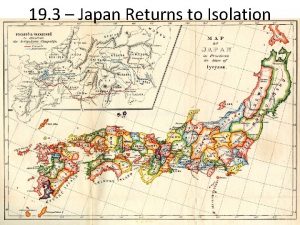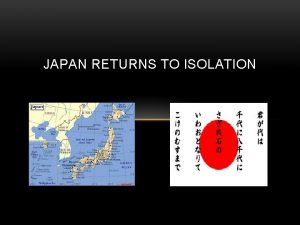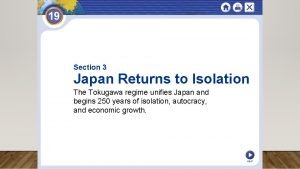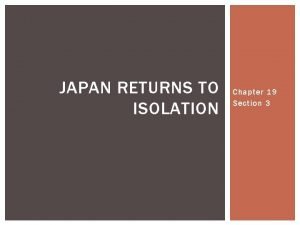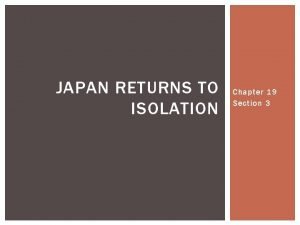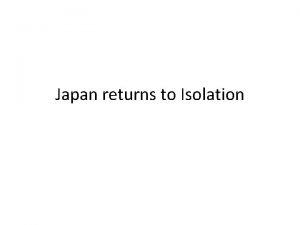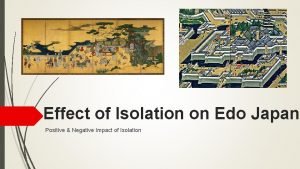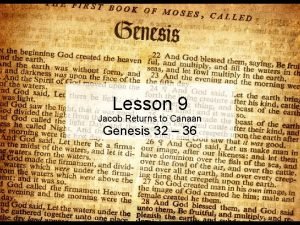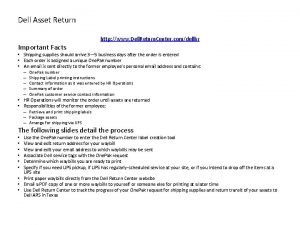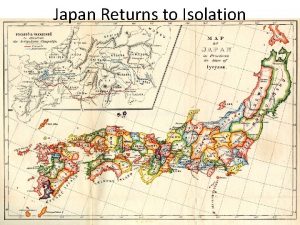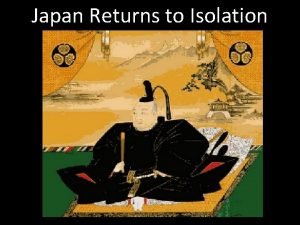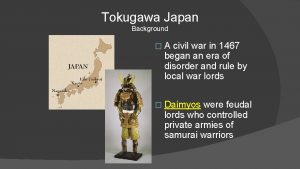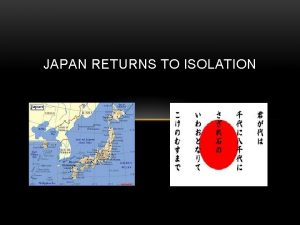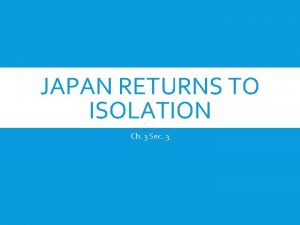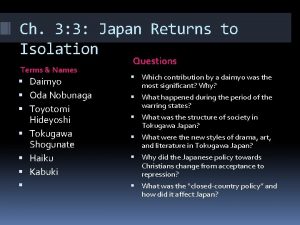19 3 Japan Returns to Isolation 1467 Civil












- Slides: 12

19. 3 – Japan Returns to Isolation

• 1467: Civil war spins Japan in chaos = violence • 1467 -1568: “Warring States” period – Samurai Daimyo rule states – Emperor = figurehead • System resembles Europe – Castles, serfs, local armies, tribute, etc. New Feudalism

New Leaders • Oda Nobunaga – seizes Kyoto in 1568 – Works to eliminate rivals & Buddhist monasteries – First to effectively use firearms – Commits seppuku (suicide) in 1582 • Toyotomi Hideyoshi – Nobunaga’s best general – 1590: Controls most of Japan through force & alliances – 1592: Invades Korea


• 1600: Tokugawa Ieyasu unites Japan • 1693: Becomes Shogun & moves capital to Edo (Tokyo) • Rebellion still prevalent; daimyo must spend time between Edo & homes – Policy brings back central government • Founds Tokugawa Shogunate (lasts until 1867) Tokugawa

Tokugawa Society • Tokugawa shoguns bring stability & prosperity – Wealth, food, & population rise • Structure: – Shogun, daimyo, samurai, peasants, artisans, then merchants • • Practice Confucian ideas Focused on agriculture Peasants faced heavy taxes Mid-1700 s: Japan shifting to an urban society

• Maintain traditions • Samurai attend nohs – Ceremonial tragic dramas • Paintings of classical literature were popular • New styles of entertainment developed • Haikus were very popular – P. 544 Tokugawa Culture

European Contact • Initially, Europeans were welcomed • 1543: Portuguese reach Japan • Introduce many new goods – Tobacco, firearms, etc. • Firearms = completely change of Japan • Many forts constructed to combat cannons

• 1549: Christian missionaries arrive • Associated w/ European traders = acceptance • Conversions upset Ieyasu – Bans Christianity in 1612 • 1637: Rebellion put down – Christians held responsible & persecuted – European missionaries exiled or killed – All forced to practice Buddhism Missionaries

Isolation • Persecution of Christians = control of foreign ideas • 1639: “Closed country policy” • Nagasaki remained open to foreign trade – Only Dutch & Chinese allowed – Trade monopoly for shogunate • Remains closed for nearly 200 years • Japanese forbidden to leave as well

QAR 1. Which contribution by a daimyo was the most significant and WHY? 2. What happened during the period of the “warring states? ” 3. What was the structure of society in Tokugawa Japan? 4. What were the new styles of drama, art, and literature in Tokuagwa Japan?

QAR 5. Why do you think that the emperor has less power than the Shogun? 6. Why did the Japanese policy towards Christians change from acceptance to repression? 7. Do you think that Japan’s closed country policy effectively Western ideas and customs out of Japan?
 Japan returns to isolation
Japan returns to isolation Japan returns to isolation
Japan returns to isolation Section 3 japan
Section 3 japan Section 3 japan
Section 3 japan Chapter 19 section 3 japan returns to isolation answer key
Chapter 19 section 3 japan returns to isolation answer key Japan returns to isolation
Japan returns to isolation Kamu yararı kararı örneği
Kamu yararı kararı örneği Tkgm 1467 sayılı genelge
Tkgm 1467 sayılı genelge 1467 sayılı genelge tkgm
1467 sayılı genelge tkgm Did isolation have a positive or negative effect on japan?
Did isolation have a positive or negative effect on japan? Civil rights webquest
Civil rights webquest Bethel bethlehem
Bethel bethlehem Dell return center
Dell return center
